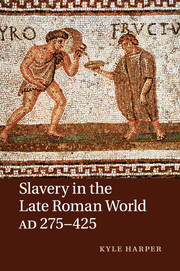Book contents
- Frontmatter
- Contents
- List of tables
- Acknowledgments
- PART I THE ECONOMY OF SLAVERY
- Introduction
- 1 Among slave systems: a profile of late Roman slavery
- 2 The endless river: the supply and trade of slaves
- 3 Oikonomia: households, consumption, and production
- 4 Agricultural slavery: exchange, institutions, estates
- PART II THE MAKING OF HONORABLE SOCIETY
- PART III THE IMPERIAL ORDER
- CONCLUSION
- APPENDIXES
- Bibliography
- Index
4 - Agricultural slavery: exchange, institutions, estates
Published online by Cambridge University Press: 05 August 2011
- Frontmatter
- Contents
- List of tables
- Acknowledgments
- PART I THE ECONOMY OF SLAVERY
- Introduction
- 1 Among slave systems: a profile of late Roman slavery
- 2 The endless river: the supply and trade of slaves
- 3 Oikonomia: households, consumption, and production
- 4 Agricultural slavery: exchange, institutions, estates
- PART II THE MAKING OF HONORABLE SOCIETY
- PART III THE IMPERIAL ORDER
- CONCLUSION
- APPENDIXES
- Bibliography
- Index
Summary
THE PROBLEM OF ROMAN AGRICULTURAL SLAVERY
In a sermon on the Gospel of Matthew, John Chrysostom asked his audience to imagine a man who wished to become wealthy. The path to riches lay in farming the land and plying the sea. The priest simply assumed that lucrative, commercial agriculture entailed “buying fields and slaves.” In another sermon, Chrysostom thundered against the greed of his flock, whose members were endlessly scheming “how to buy land, how to buy slaves, and how to make money.” These sermons are part of a broad body of evidence that testifies to the importance of agricultural slavery in the late empire. Chrysostom's contemporaries, too, frequently noticed the prevalence of slavery in agricultural production. The imperial constitutions preserved in the Theodosian Code repeatedly confirm the existence of rural slaves, not only in theoretical terms, but in actual land transactions. The papyri of fourth-century Egypt document the presence of slaves on rural estates. The inscriptions of late antiquity provide incomparable testimony for large, slave-based properties, not least in the form of the remarkable stones uncovered on Thera. The evidence for agricultural slavery in the fourth century is abundant and credible – arguably as rich as for any period of classical antiquity.
- Type
- Chapter
- Information
- Slavery in the Late Roman World, AD 275–425 , pp. 144 - 200Publisher: Cambridge University PressPrint publication year: 2011

